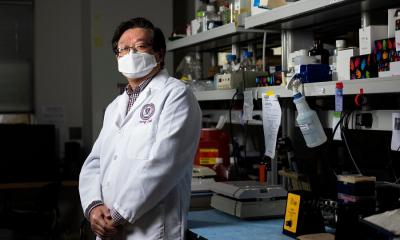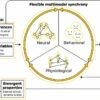A candidate vaccine that could provide protection against the COVID-19 virus and other coronaviruses has shown promising results in early animal testing.
The candidate coronavirus vaccines, created by Virginia Tech’s University Distinguished Professor X.J. Meng and UVA Health’s Professor Steven L. Zeichner, prevented pigs from being becoming ill with a pig coronavirus, porcine epidemic diarrhea virus (PEDV).
The researchers have recently published their findings in the Proceedings of the National Academy of Sciences.
“The candidate vaccine was developed using an innovative vaccine platform targeting a highly conserved genomic region of coronaviruses,” said Meng, a University Distinguished Professor in the Department of Biomedical Sciences and Pathobiology in the Virginia-Maryland College of Veterinary Medicine. “The new vaccine platform utilizes a genome-reduced bacteria to express the coronavirus vaccine antigen on its surface. Such a vaccine platform can be manufactured with low cost in existing facilities around the world, which could meet the pandemic demand.”
Their coronavirus vaccine offers several advantages that could overcome major obstacles to global vaccination efforts. It would be easy to store and transport, even in remote areas of the world, and could be produced in mass quantities using existing vaccine-manufacturing factories.
“Our new platform offers a new route to rapidly produce vaccines at very low cost that can be manufactured in existing facilities around the world, which should be particularly helpful for pandemic response,” said Zeichner.
A new vaccine-development approach
The new vaccine-production platform involves synthesizing DNA that directs the production of a piece of the virus that can instruct the immune system how to mount a protective immune response against a virus.
That DNA is inserted into another small circle of DNA called a plasmid that can reproduce within bacteria. The plasmid is then introduced into bacteria, instructing the bacteria to place pieces of proteins on their surfaces. The technique uses the common bacteria E. coli.
One major innovation is that the E. coli have had a large number of its genes deleted. Removing many of the bacteria’s genes, including genes that make up part of its exterior surface or outer membrane, appears to substantially increase the ability of the immune system to recognize and respond to the vaccine antigen placed on the surface of the bacteria. To produce the vaccine, the bacteria expressing the vaccine antigen are simply grown in a fermenter, much like the fermenters used in common microbial industrial processes like brewing, and then killed with a low concentration of formalin.
“Killed whole-cell vaccines are currently in widespread use to protect against deadly diseases like cholera and pertussis. Factories in many low-to-middle-income countries around the world are making hundreds of millions of doses of those vaccines per year now, for a $1 per dose or less,” Zeichner said. “It may be possible to adapt those factories to make this new vaccine. Since the technology is very similar, the cost should be similar too.”
The entire process, from identifying a potential vaccine target to producing the gene-deleted bacteria that have the vaccine antigens on their surfaces, can take place very quickly, in only two to three weeks, making the platform ideal for responding to a pandemic.
Targeting COVID-19
The team’s candidate vaccines take an unusual approach in that it targets a part of the spike protein of the virus, the “viral fusion peptide,” that is highly universal among coronaviruses. The fusion peptide has not been observed to differ at all in the many genetic sequences of SARS-CoV-2, the virus that causes COVID-19, that have been obtained from thousands of patients around the world during the course of the pandemic.
“With the emergence of various SARS-CoV-2 variants, a vaccine targeting a conserved region of all coronaviruses, such as the fusion peptide, may potentially lead to a broadly protective candidate vaccine. Such a vaccine, if successful, would be of significant value against variant virus strains,” said Meng, who is also the founding director of the Center for Emerging, Zoonotic, and Arthropod-borne Pathogens in the Fralin Life Sciences Institute at Virginia Tech.
To create their vaccine, the researchers used the new vaccine platform, synthesizing the DNA with the instructions to make the fusion peptide and engineered bacteria to place the proteins on the surface of the bacteria that had a large number of its genes removed, then grew and inactivated the bacteria to make the candidate coronavirus vaccine.
Meng and Zeichner made two vaccines, one designed to protect against COVID-19, and another designed to protect against the pig coronavirus, PEDV. PEDV and SARS-CoV-2, the virus that causes COVID-19, are both coronaviruses, but they are distant relatives. PEDV and SARS-CoV-2, like all coronaviruses, share a number of core amino acids that constitute the fusion peptide. PEDV infects pigs, causing diarrhea, vomiting, and high fever and has been a large burden on pig farmers around the world. When PEDV first appeared in pig herds in the U.S. in 2013, it killed millions of pigs in the United States alone.
One advantage of studying PEDV in pigs is the researchers could study the ability of the vaccines to offer protection against a coronavirus infection in its native host—in this case, pigs. The other models that have been used to test COVID-19 vaccines study SARS-CoV-2 in nonnative hosts, such as monkeys or hamsters, or in mice that have been genetically engineered to enable them to be infected with SARS-CoV-2. Pigs are also very similar in physiology and immunology to people—they may be the closest animal models to people other than primates.
In some unexpected results, Meng and Zeichner observed that both the candidate vaccine against PEDV and the candidate vaccine against SARS-CoV-2 protected the pigs against illness caused by PEDV. The vaccines did not prevent infection, but they protected the pigs from developing severe symptoms, much like the observations made when primates were tested with candidate COVID-19 vaccines. The vaccines also primed the immune system of the pigs to mount a much more vigorous immune response to the infection. If both the PEDV and the COVID-19 vaccines protected the pigs against disease caused by PEDV and primed the immune system to fight the disease, it is reasonable to think that the COVID-19 vaccine would also protect people against severe COVID-19 disease.
Next steps
Additional testing—including human trials—would be required before the COVID-19 vaccine could be approved by the federal Food and Drug Administration or other regulatory agencies around the world for use in people, but the collaborators are pleased by the early successes of the vaccine-development platform.
“Although the initial results in the animal study are promising, more work is needed to refine both the vaccine platform using different genome-reduced bacterial strains and the fusion peptide vaccine target,” said Meng. “It will also be important to test the fusion peptide vaccine in a monkey model against SARS-CoV-2 infection.”
Zeichner added that he was encouraged that a collaboration between UVA and Virginia Tech, schools with a well-known sports rivalry, has produced such promising results.
“If UVA and Virginia Tech scientists can work together to try to do something positive to address the pandemic, then maybe there is some hope for collaboration and cooperation in the country at large,” said Zeichner.
Follow the latest news on the coronavirus (COVID-19) outbreak
More information:
Denicar Lina Nascimento Fabris Maeda et al. Killed whole-genome reduced-bacteria surface-expressed coronavirus fusion peptide vaccines protect against disease in a porcine model, Proceedings of the National Academy of Sciences (2021). DOI: 10.1073/pnas.2025622118
Citation:
Virologists develop broadly protective coronavirus vaccines (2021, April 16)
retrieved 17 April 2021
from https://medicalxpress.com/news/2021-04-virologists-broadly-coronavirus-vaccines.html
This document is subject to copyright. Apart from any fair dealing for the purpose of private study or research, no
part may be reproduced without the written permission. The content is provided for information purposes only.



